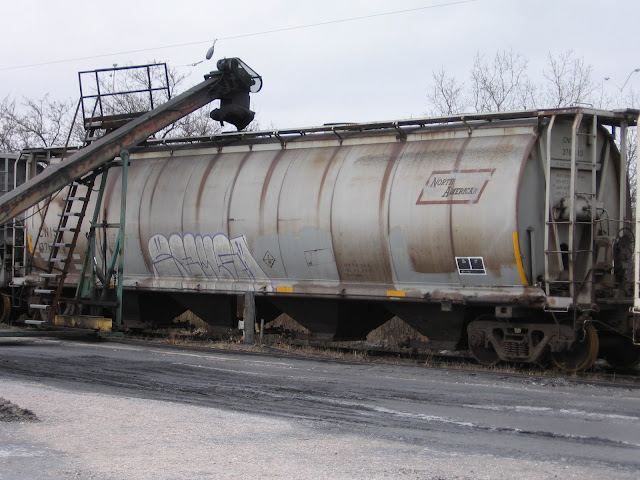So, with last week's start behind us, I humbly present the second reason why it's important to photograph rolling stock.
2. Photographing rolling stock is perhaps the best way we can learn about railway history these days.
Let's face it. The major North American railways are not all that concerned with their history (Norfolk Southern is the one exception and Union Pacific has some reasonable heritage units). For the most part, your best bet for catching a glimpse of rail history is to find it on an old car. And, given the life span of cars, many of these old cars will likely not be on the rails much longer.
Take the picture above (August 2016) for example. Those of us who have been around know all about Canadian Pacific's former incarnation as CP Rail. I'm sure many of us take it for granted. But how many young railfans weren't around during the multimark era and don't know anything about the CP Rail incarnation?
Here are a few additional photos of some fallen flags or relics.
Conrail (Summer 1992, Sarnia Yard) These old high-cubes were once common, but they are rare now. Check out the massive double doors. You can even see a little glimpse of an old GT high cube to the left.
Family Lines System/Louisville & Nashville (Summer 2014, Sarnia Yard). There are few railways with a more colourful lineage than CSX.
Sclair and Dupont (Summer 1992, Serviplast Spur, near Corunna). These hoppers are still around, thankfully. How many cars in private fleets were or are as creatively decked out than these hoppers?
CN International Service North American scheme (December 2013, near Donahue Bridge, Sarnia). Who remembers this scheme on CN and CP international service cars? I used to see them all the time but was shocked to see on back in 2013.
Burlington Northern (October 2016, Sarnia Yard). Thankfully, BN cars are still pretty common. I have always thought BN was one of the coolest looking railways. I loved the logo and the colour scheme. Much better than the ultra modern BNSF Great Northern knock-off look.
Southern Railway (October 2016, Strathroy Subdivision, Sarnia). How many railways put as much thought into their advertising than the Southern? These cars are still around, but I found they have dwindled in recent years.
Chicago & Northwestern (April 2014, Smiths Falls Sub, Ottawa). I love coming across cars where the heritage is literally bleeding through, despite efforts to repatch.
Soo Line (June 2014, Twin Elm, Ontario). The Soo is still a common site, given its longstanding association and integration in the Canadian Pacific system. Still, it's a railway with a colourful history that is starting to fade. How any Soo-painted units are left out there? How many Soo hoppers are left with the wheat sheaf on the side?
These are just a few examples of some of the rail history I have caught trackside over the years. On the surface, there is nothing fancy about these pictures on their own, but I think they collectively tell a fascinating story. Things weren't always like they are today. I'm not saying it was better trackside thirty years ago (okay I might be, but I don't want to sound like a grumpy old man), but it was different. And that's a story worth telling. Who can say what railways will look like in another few decades? Given how much change we've seen even in the last ten years, it seems like snapping a few mundane shots of rolling stock is a worthy exercise.










4 comments:
Michael - Speaking of grumpy...Eric here. Excellent take on the subject of rolling stock for RSAS Session II. Your history angle is an important one. Those logos do show the progression of consolidation over the last few decades. Even the North American leasing logo was an indication of things to come - not only in the fleet progression towards covered hoppers and tanks - but also the shift to private ownership away from railway ownership.
Even a given piece or class of rolling stock can show 'history'. That CP boxcar has had roof-level vents added to allow the shipping of 'wet' paper products. This shows the railway making efforts to have their rolling stock fleet match changing customer demand, and the evolution of new lading over time.
Rolling stock has also provided a rolling billboard on which a company's products can be advertised. SCLAIR is a great example. (Person stuck at crossing "Hey, I wonder if there are any new resins for sale by DuPont?")
All those cars you chose are indeed historic, indeed photographable and indeed reinforce the importance of rolling stock photography. Hey, perhaps all blogs should just show rolling stock photos!! (Nah, that would be boring.)
Thanks for posting and have a great weekend!
Seeing these "fallen flags" or previous schemes leads to curiosity which can lead to research... always a good thing.
Out of your photos, I see mostly CNW and SOO and a few Southerns around here. I have yet to see a Sclair but I hope to, someday. I guess I'll have to go to Ontario.. :)
Thanks for reminding me of the modifications to the CP Rail boxcar, Eric. I meant to mention them in the post, but I obviously left that out. Good to know what it was I was looking at, since I wasn't sure. It's funny you mention Ontario, Steve. I see Western Canada as the gold standard for railfanning myself. I guess it's all a matter of perspective.
Those "North American" hoppers were leased from North American Car Co. and that's that company's logo on the car. NACC's lease fleet later became part of GE Capital.
Post a Comment